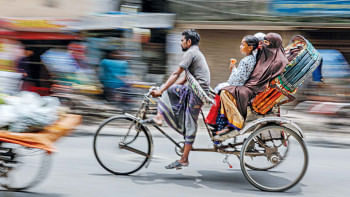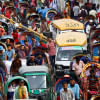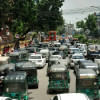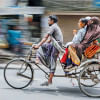Battery-powered rickshaw is the way forward

Since the British era, pedal rickshaws have been at the forefront of urban and rural transportation for the entire population of Bangladesh. Be it taking children to school, going to bazaar for groceries, or enjoying an afternoon ride, generations of families have enjoyed door-to-door services of rickshaws in their daily lives. Pedal rickshaws are embedded in our culture, much like Bangkok's iconic "Tuktuks," the Filipino "Habal Habal" or Kolkata's hand-pulled rickshaws. Rickshaws were originally introduced in the subcontinent by the colonialists to exercise their power and portray class differences to the colonised.
In recent years, there has been a debate about the suitability of pedal versus battery-powered rickshaws in today's Bangladesh. We also witnessed demonstrations by both groups of rickshaw drivers in recent months. Both types of rickshaws have benefits and drawbacks, so there needs to be a thorough analysis at the national level to determine the future of millions of rickshaw pullers and drivers. This article will try to dig into the arguments raised by different groups from a socio-economic perspective.
One of the major challenges in incorporating battery-powered rickshaws into our cities is the cost of batteries and their installation. For rickshaw pullers, most of whom are financially vulnerable, transitioning to battery-powered rickshaws can be a costly undertaking with many, particularly in Dhaka, not owning their rickshaws. Instead, they rent them from contractors or businessmen who typically have fleets of 10 to 20 rickshaws, charging a fixed daily fee. As battery-powered rickshaws gain popularity, more owners are likely to replace traditional pedal rickshaws with battery-operated ones. However, the high cost of batteries may force them to reduce the size of their fleets, which could lead to significant unemployment in the rickshaw industry.
Another issue is that 90 percent of the nation's rickshaw-charging garages rely on illegal or bypassed electricity connections. As a result, rickshaw pullers do not pay for electricity, causing losses for the Dhaka Power Distribution Company, Dhaka Electric Supply Company, and Bangladesh Rural Electrification Board.
However, battery-powered rickshaws offer greater mobility compared to pedal rickshaws due to their consistent speed and longer range. According to a research paper titled "Impact of Pedal Powered Vehicles on Average Traffic Speed in Dhaka City," roads without rickshaws have an average speed of about 20 kilometres per hour, whereas roads with rickshaws average only 11 kilometres per hour. This shows that pedal rickshaws slow down traffic, creating obstacles for cars, motorcycles, and buses.
Currently, almost the entire rickshaw industry operates within the grey economy, meaning it is neither taxed nor regulated by the government. This lack of oversight leads to frequent unlawful activities, including traffic violations, bribery, corruption, and syndicate involvement. A major concern with battery-powered rickshaws is the risk of serious injuries to both pedestrians and passengers in the event of an accident. The fragile structure of these vehicles, combined with their relatively high speeds, does not offer enough safety for the users and passengers.
Rickshaw lanes are not a groundbreaking idea or revolutionary policy in Bangladesh. They have been often advocated as a solution and successfully implemented in some areas, including the Bashundhara residential area, which shows how traffic could improve if rickshaw lanes were introduced throughout Dhaka and other cities. Adding dedicated rickshaw lanes would enhance mobility and safety by separating rickshaws from motor vehicles. Establishing these lanes on the far left side of roads would not only address the speed mismatch between rickshaws and motor vehicles but also help reduce illegal parking issues. According to a study by Bari and Efroymson (2006), parked cars are the "least efficient users of spaces," so creating rickshaw lanes would yield greater benefits. Although some argue that developing nations face a "shortage of road space" for separate lanes, this is a crucial step toward ensuring safety and smoother traffic flow.
Moreover, battery-powered rickshaws should be regulated to generate revenue from charging. Similar to gas stations, rickshaw charging stations can be established in various areas. These stations could also incorporate solar systems to alleviate some pressure on the electricity grid. Additionally, separate metres and electricity pricing—aligning with rickshaw fares and the average income of rickshaw pullers—should also be implemented. Plans also must consider fare limits for rickshaws to ensure economic accessibility for people from all income backgrounds.
The rickshaw industry requires digitalisation similar to most other industries in Bangladesh. A complete switch to battery-powered rickshaws would be a key step forward. These rickshaws ease the physical strain on drivers and create an income option for the elderly and disabled. In some areas, rickshaw pullers require a licence to operate. Ensuring that they carry their licence will ensure they are held accountable for traffic violations.
In fact, it is essential to bring the entire industry under government administration and include services such as registration of rickshaws, appropriate training to ensure compliance with traffic rules, etc. Currently, there is no national law governing rickshaws. They are controlled by individual municipalities and city corporations. So it is important to introduce a national-level legal framework based on which local governments can add their own regulations in their respective localities. The national framework must include separate lanes for rickshaws in three-lane or wider roads, mandatory speed limits that may vary according to area, and limits on the number of rickshaws allowed to ply in a particular area to control congestion. Strict implementation of these rules at the national and local levels will ensure improvements in traffic congestion and road safety.
It is a complex task to legalise and implement regulations for battery-powered rickshaws, and the issue is exacerbated by the electric power consumption concerns and economic consequences on pedal rickshaw pullers. However, in the long run, battery-powered rickshaws have to be incorporated in our society because of the benefits they offer—higher speed and accessibility. Steps can be taken to improve the structural integrity of battery-powered rickshaws to address safety concerns. The government must ensure a smooth transition to battery power-rickshaws so that all parties can benefit from it.
Prity Rayhan is a student in the economics and social sciences department of BRAC University. She can be reached at [email protected].
Tashriq Estiaq Syed is a student in the economics and social sciences department of BRAC University. He can be reached at [email protected].
Views expressed in this article are the authors' own.
Follow The Daily Star Opinion on Facebook for the latest opinions, commentaries and analyses by experts and professionals. To contribute your article or letter to The Daily Star Opinion, see our guidelines for submission.


 For all latest news, follow The Daily Star's Google News channel.
For all latest news, follow The Daily Star's Google News channel. 











Comments